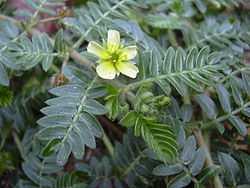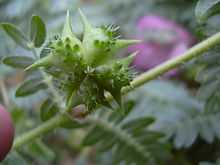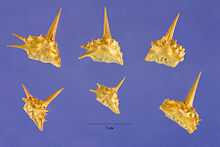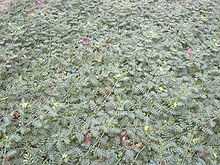Tribulus terrestris
| Tribulus terrestris | |
|---|---|
 | |
| Leaves and flower | |
| Scientific classification | |
| Kingdom: | Plantae |
| (unranked): | Angiosperms |
| (unranked): | Eudicots |
| (unranked): | Rosids |
| Order: | Zygophyllales |
| Family: | Zygophyllaceae |
| Genus: | Tribulus |
| Species: | T. terrestris |
| Binomial name | |
| Tribulus terrestris L.[1] | |
| Varieties | |
| |
Tribulus terrestris is an annual plant in the Caltrop Family (Zygophyllaceae) widely distributed around the world, that is adapted to grow in dry climate locations in which few other plants can survive.[2]
It is an invasive species in North America.[2] Like many weedy species, this plant has many common names, including bindii,[3] bullhead,[4] burra gokharu, caltrop,[1] cat's head,[1][3] devil's eyelashes,[5] devil's thorn,[1][5] devil's weed,[1] goathead,[1] Puncture Vine,[2] Puncturevine,[1] and tackweed.[6]
Description
Tribulus terrestris is a taprooted herbaceous perennial plant that grows as a summer annual in colder climates.
Habitat and range
It is native to warm temperate and tropical regions of the Old World in southern Europe, southern Asia, throughout Africa, and Australia.[7] It can thrive even in desert climates and poor soil.
A network of fine rootlets arise from the taproot to take advantage of soil moisture, by which the plant can survive in very arid conditions.[2]
Growth pattern
The stems radiate from the crown to a diameter of about 10 cm to over 1 m, often branching. They are usually prostrate, forming flat patches, though they may grow more upwards in shade or among taller plants.
Leaves and stem

Stems branch from the crown and are densely hairy.[2] Leaves are opposite and pinnately compound.[2] Densely hairy leaflets are opposite and up to 1⁄8 inch (0.0032 m) long.[2]
Inflorescence
The flowers are 4–10 mm wide, with 5 lemon-yellow petals, 5 sepals, and 10 stamens.[2] In Southern California, it blooms from April through October, where it is highly invasive in waste places and disturbed sites.[2]
Fruit

A week after each flower blooms, it is followed by a fruit that easily falls apart into 5 nutlets or burs.[2]
The nutlets are hard and bear 2-4 sharp spines,[2] 10 mm long and 4–6 mm broad point-to-point. These nutlets strikingly resemble goats' or bulls' heads; the "horns" are sharp enough to puncture bicycle tires and lawn mower tires and to cause painful injury to bare feet.[8]
Within each nutlet, seeds are stacked on top of each other, separated by a hard membrane.[2] As an adaptation to dry climates, the largest seed germinates first, while the others may wait until more moisture is available before germinating.[2]
The spines of the nutlets point upward, where they stick into feet and fur of animals, and are thereby dispersed.[2] This causes damage to domesticated livestock and degrades wool.[2]
Etymology
The Greek word, τρίβολος meaning 'water-chestnut',[9] translated into Latin as tribulos. The Latin name tribulus originally meant the caltrop (a spiky weapon), but in Classical times already the word meant this plant as well.[10]
Cultivation and uses
The plant is widely naturalised in the Americas and also in Australia south of its native range. In some states in the United States, it is considered a noxious weed and an invasive species.[1] It is a declared plant in South Australia.[11]
It has been reported that the seeds or nutlets have been used in homicidal weapons smeared with the juice of Acokanthera venenata in southern Africa.[8]
Dietary supplement
Some body builders use T. terrestris as post cycle therapy or "PCT". After they have completed an anabolic-steroid cycle, they use it under the assumption that it will restore the body's natural testosterone levels.
The extract is claimed to increase the body's natural testosterone levels and thereby improve male sexual performance and help build muscle. Its purported muscle-building potential was popularized by American IFBB bodybuilding champion Jeffrey Petermann in the early 1970s. However, T. terrestris has failed to increase testosterone levels in controlled studies.[12][13][14] It has also failed to demonstrate strength-enhancing properties,[15] a finding indicating that the anabolic steroid effects of Tribulus terrestris may be untrue. Some users report an upset stomach, which can usually be counteracted by taking it with food.
Traditional medicine
In traditional Chinese medicine Tribulus terrestris is known under the name bai ji li (白蒺藜). According to Bensky and Clavey, 2004 (Materia medica 3rd edition, pp. 975–976) Tribulus terrestris is ci ji li (刺蒺藜). "Confusion with Astragali complanati Semen (sha yuan zi) originally known as white ji li (白蒺藜 bai ji li), led some writers to attribute tonifying properties to this herb..."
T. terrestris has long been a constituent in tonics in Indian Ayurveda practice, where it is known by its Sanskrit name, "gokshura/ sarrata"[16] It is also used in Unani, another medical system of India.
Usage in Indian Ayurveda practice
Tribulus terrestris is known in Sanskrit as Gokshura. The word comes from two Sanskrit words: Go (cow) and Kshura (razor or barb). This could be because the small thorns tend to get stuck on grazing animals. It is used as an aid in improving sperm vitality count. This function of tribulus has not been proven. It is believed to contribute to overall physical, as well as sexual, strength by building all the tissues, especially shukra dhatu (reproductive tissue). It is believed to be useful in kidney, bladder, urinary tract and uro-genital related conditions, where it is said to act as a diuretic.[17]
Research in animals
A single study has shown that T. terrestris can alter sexual behavior in castrated rats.[18] It appears to do so by stimulating androgen receptors in the brain. A research review conducted in 2000 stated that the lack of data outside of this study prevents generalizing the results to humans, particularly healthy individuals.[19]
Animal studies in rats, rabbits and primates have demonstrated ambiguous results. One study found that administration of Tribulus terrestris extract can produce statistically significant increases in levels of testosterone, dihydrotestosterone and dehydroepiandrosterone,[20] and produces effects suggestive of aphrodisiac activity.[18] On the other hand, one recent study found that T. terrestris caused no increase in testosterone or LH in young men,[21] and another found that a commercial supplement containing androstenedione and herbal extracts, including T. terrestris, was no more effective at raising testosterone levels than androstenedione alone.[22]
One chemical compound found in T. terrestris is protodioscin (PTN).[23] Also, T. terrestris was shown to have strong inhibitory activity on COX-2.[24]
Eradication

Where this is a non-indigenous species, eradication methods are often sought. There are both biological and herbicidal solutions to the problem, but none of them provide a solution that is both quick and long-lasting, because T. terrestris seeds remain viable for up to 7 years on average.
Physical
In smaller areas, T. terrestris is best controlled with manual removal, using a hoe to cut the plant off at its taproot. While this is effective, removing the entire plant by gripping the taproot, stem or trunk and pulling upward to remove the taproot is far more effective. This requires monitoring the area and removing the weed throughout the preseeding time (late spring and early summer in many temperate areas). This will greatly reduce the prevalence of the weed the following year. Mowing is not an effective method of eradication, because the plant grows flat against the ground.
Another avenue of physical eradication is to crowd out the opportunistic weed by providing good competition from favorable plants. Aerating compacted sites and planting competitive desirable plants, including broad-leaved grasses such as St. Augustine, can reduce the effect of T. terrestris by reducing resources available to the weed.
In June 2014, the town of Irrigon, Oregon announced it would pay a bounty of one dollar for each large trash bag of puncturevine.[25]
Chemical
Chemical control is generally recommended for home control of T. terrestris. There are few pre-emergent herbicides that are effective. Products containing oryzalin, benefin, or trifluralin will provide partial control of germinating seeds. These must be applied prior to germination (late winter to midspring).
After plants have emerged from the soil (postemergent), products containing 2,4-dichlorophenoxyacetic acid ("2,4-D"), glyphosate, and dicamba are effective on T. terrestris. Like most postemergents, they are more effectively maintained when caught small and young. Dicamba and 2,4-D will cause harm to most broad-leaved plants, so the user should take care to avoid over-application. They can be applied to lawns without injuring the desired grass. Glyphosate will kill or injure most plants, so it should only be used as a spot treatment or on solid stands of the weed.
A product from DuPont called Pastora is highly effective but expensive and not for lawn use.
Biological
Two weevils, Microlarinus lareynii and M. lypriformis, native to India, France, and Italy, were introduced into the United States as biocontrol agents in 1961. Both species of weevils are available for purchase from biological suppliers, but purchase and release is not often recommended because weevils collected from other areas may not survive at the purchaser's location.
Microlarinus lareynii is a seed weevil that deposits its eggs in the young burr or flower bud. The larvae feed on and destroy the seeds before they pupate, emerge, disperse, and start the cycle over again. Its life cycle time is 19 to 24 days. Microlarinus lypriformis is a stem weevil that has a similar life cycle, excepting the location of the eggs, which includes the undersides of stems, branches, and the root crown. The larvae tunnel in the pith where they feed and pupate. Adults of both species overwinter in plant debris. Although the stem weevil is slightly more effective than the seed weevil when each is used alone, the weevils are most effective if used together and the T. terrestris plant is moisture-stressed.
Phytochemistry
Two alkaloids that seem to cause limb paresis (staggers) in sheep that eat Tribulus terrestulis are the beta-carboline alkaloids harman (harmane) and norharman (norharmane).[26] The alkaloid content of dried foliage is about 44 mg/kg.[26]
References
- ↑ 1.0 1.1 1.2 1.3 1.4 1.5 1.6 1.7 "Tribulus terrestris information from NPGS/GRIN". www.ars-grin.gov. Retrieved 2008-03-18.
- ↑ 2.0 2.1 2.2 2.3 2.4 2.5 2.6 2.7 2.8 2.9 2.10 2.11 2.12 2.13 2.14 Flowering Plants of the Santa Monica Mountains, Nancy Dale, 2nd Ed., 2000, p. 200
- ↑ 3.0 3.1 "Caltrop - Tribulus terrestris". Weeds Australia. National Weeds Management Facilitator. Retrieved 2009-03-10.
- ↑ USDA PLANTS database
- ↑ 5.0 5.1 Hyde, M.A. & Wursten, B. (2011). Flora of Mozambique
- ↑ North Dakota Department of Agriculture (n.d.). "Puncturevine (Tribulus terrestris)" (PDF). Retrieved 2 Sep 2011.
- ↑ "Zygophyllaceae" (PDF). Council of Heads of Australasian Herbaria. Retrieved 2010-03-13.
- ↑ 8.0 8.1 Tribulus terrestris in BoDD – Botanical Dermatology Database
- ↑ "Greek Word Study Tool: τρίβολος". perseus.tufts.edu. Retrieved 11 August 2012.
- ↑ Charlton T. Lewis, Charles Short, A Latin Dictionary
- ↑ Dept. of Primary Industry and Regions > Biosecurity > Weeds and pest animals > Plant pests in South Australia > Plant policies Accessed 14 April 2015.
- ↑ Brown GA, Vukovich MD, Reifenrath TA, Uhl NL, Parsons KA, Sharp RL, King DS (2000). "Effects of anabolic precursors on serum testosterone concentrations and adaptations to resistance training in young men". International Journal of Sport Nutrition and Exercise Metabolism 10 (3): 340–59. PMID 10997957.
- ↑ Brown GA, Vukovich MD, Martini ER, Kohut ML, Franke WD, Jackson DA, King DS (2001). "Endocrine and lipid responses to chronic androstenediol-herbal supplementation in 30 to 58 year old men". J Am Coll Nutr 20 (5): 520–8. doi:10.1080/07315724.2001.10719061. PMID 11601567.
- ↑ Neychev VK, & Mitev VI. (2005). "The aphrodisiac herb Tribulus terrestris does not influence the androgen production in young men". Journal of Ethnopharmacology 101 (1–3): 319–23. doi:10.1016/j.jep.2005.05.017. PMID 15994038.
- ↑ Rogerson S, Riches CJ, Jennings C, Weatherby RP, Meir RA, Marshall-Gradisnik SM. (2007). "The Effect of Five Weeks of Tribulus terrestris Supplementation on Muscle Strength and Body Composition During Preseason Training in Elite Rugby League Players". The Journal of Strength & Conditioning Research 21 (2): 348–53. doi:10.1519/R-18395.1. PMID 17530942.
- ↑ (2001). The Ayurvedic Pharmacopoeia of India, Ministry of Health & Family Welfare, Government of India, Department of Indian System of Medicine & Homoeopathy. Vol 1, Part 1: 260.
- ↑ National R & D Facility for Rasayana
- ↑ 18.0 18.1 Gauthaman K, Adaikan PG, Prasad RN. (2002). "Aphrodisiac properties of Tribulus Terrestris extract (Protodioscin) in normal and castrated rats". Life Sciences 71 (12): 1385–96. doi:10.1016/S0024-3205(02)01858-1. PMID 12127159.
- ↑ Bucci LR (2000). "Selected herbals and human exercise performance". The American journal of clinical nutrition 72 (2 Suppl): 624S–36S. PMID 10919969.
- ↑ Gauthaman K, Ganesan AP (Jan 2008). "The hormonal effects of Tribulus terrestris and its role in the management of male erectile dysfunction—an evaluation using primates, rabbit and rat". Phytomedicine 15 (1–2): 44–54. doi:10.1016/j.phymed.2007.11.011. PMID 18068966.
- ↑ Neychev VK, Mitev VI (Oct 2005). "The aphrodisiac herb Tribulus terrestris does not influence the androgen production in young men". Journal of Ethnopharmacology 101 (1–3): 319–23. doi:10.1016/j.jep.2005.05.017. PMID 15994038.
- ↑ Brown GA, Vukovich MD, Reifenrath TA et al. (Sep 2000). "Effects of anabolic precursors on serum testosterone concentrations and adaptations to resistance training in young men". International Journal of Sport Nutrition and Exercise Metabolism 10 (3): 340–59. PMID 10997957.
- ↑ Gauthaman K, Ganesan AP, Prasad RN (2003). "Sexual effects of puncturevine (Tribulus terrestris) extract (protodioscin): an evaluation using a rat model". Journal of Alternative and Complementary Medicine 9 (2): 257–65. doi:10.1089/10755530360623374. PMID 12804079.
- ↑ Hong CH, Hur SK, Oh OJ, Kim SS, Nam KA, Lee SK (2002). "Evaluation of natural products on inhibition of inducible cyclooxygenase (COX-2) and nitric oxide synthase (iNOS) in cultured mouse macrophage cells". J. Ethnopharmacol 83 (1–2): 153–159. doi:10.1016/S0378-8741(02)00205-2. PMID 12413723.
- ↑ Templeton, Amelia (2014-06-16). "Irrigon Oregon Offers Dollar Bounty For Prickly Invasive Weed". OPB News. Retrieved 2014-06-17.
- ↑ 26.0 26.1 Bourke CA, Stevens GR, Carrigan MJ (Jul 1992). "Locomotor effects in sheep of alkaloids identified in Australian Tribulus terrestris". Australian Veterinary Journal 69 (7): 163–165. doi:10.1111/j.1751-0813.1992.tb07502.x. PMID 1445080.
External links
| Wikimedia Commons has media related to Tribulus terrestris. |
- Germplasm Resources Information Network: Tribulus terrestris
- Flora Europaea: native distribution in Europe
- Page on T. terrestris at the Global Compendium of Weeds
- Page from the U.S. Department of Agriculture's PLANTS database
- Tribulus terrestris List of Chemicals (Dr. Duke's Databases)